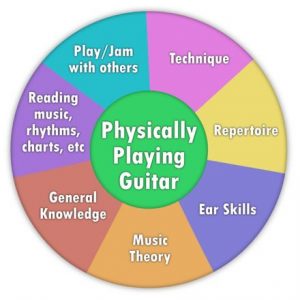Guitar Cool: The 80/20 Rule and How it Applies to Guitar
Guitar Cool: The 80/20 Rule and How it Applies to Guitar
If you search ‘guitar lessons’ online something like hundreds of millions of guitar lessons come up! Almost all apply to physically playing the guitar – how to play different chords, songs, riffs, scales, solos, etc. However, not enough people realise that only approximately 20% of what you need to know on guitar is about physically playing it.
The other 80% is what I call the head stuff. What we most probably don’t need now is more guitar lessons if there are already too many millions online. What we do need is advice on the head stuff that’s missing…
So, what exactly is this head stuff? For beginners it entails things like; instrumental technique, learning a repertoire, ear-training, music theory, general musical knowledge, understanding rhythm and maybe reading music charts, etc.
 For intermediate players it will include things like taking those previously learnt aspects to higher levels; but also include songwriting, performing, metronome techniques, improvisation if it is your thing, learning how to set goals and achieve them, learning to actively listen, etc.
For intermediate players it will include things like taking those previously learnt aspects to higher levels; but also include songwriting, performing, metronome techniques, improvisation if it is your thing, learning how to set goals and achieve them, learning to actively listen, etc.
For more advanced players it will include things like taking the previous intermediate things to higher levels; plus including recording techniques, production, maybe music business skills (which are very wide ranging), learning to perform at more advanced levels and at a consistently high standard, getting more gigs, etc.
There are more things that could easily have been added and I’m sure you can think of a few right now yourself, but it is easily seen that physically playing guitar at any level is a relatively small part of being a good musician or musicianship in general. Assuming most people reading this article will be learners I will lay out some ideas for practising those six areas here.
• Physically playing guitar – is the act of warming the fingers up, practising, playing and trying things for fun, etc.
• Technique – includes learning how to change chords from one to the other effortlessly, how to strum, to create simple grooves with your playing, etc.
• Learning a repertoire – is about the need to devote time each day to learning songs. After all that is what we learn music for, to play songs, and when we get together with others to play the first thing they ask is how many songs can you play, or can you play the songs they know?
• Ear-training – you also need to devote some time to learning what intervals and chord progressions sound like, so you can
learn your favourite songs, riffs, and solos by ear.
• Music theory – here you would devote some time to learn how music works, how it is put together. Although many players think otherwise, understanding theory is a game changer for most.
• General knowledge – includes understanding how other instruments work, what those instruments sound like, the different genres of music and what makes them different, etc.
• Learning to read charts, rhythms, notation etc. – Many guitar players despise learning to read music, but at some stage you are going to come up against needing to read a chord chart. You don’t need to know a lot of music notation at this level, but the confidence to read a simple chord chart will definitely have you well along the track.
• Performing – this includes playing music with others in groups and jamming with friends, maybe playing an open mic night if you are confident enough.
That sounds like quite a lot, right? So you might be thinking, ‘I haven’t got enough time to practise all this stuff you are proposing.’ Well, I have some simple ideas for that. Generally, physically playing guitar, technique, and learning songs are the big areas you need to practice each day. You could easily include one of each of these other skills (like ear-training, theory, general knowledge, and reading), one per day, and rotate them around. I hope you get a lot out of this and enjoy putting it into practice.
Kevin Downing is a professional NZ guitarist and published author with many other articles on his website www.guitar.co.nz
